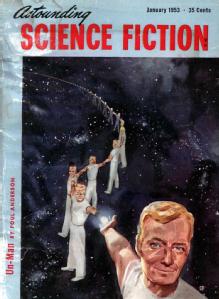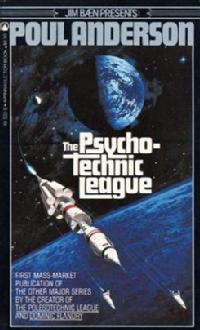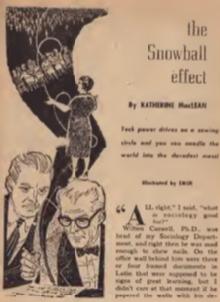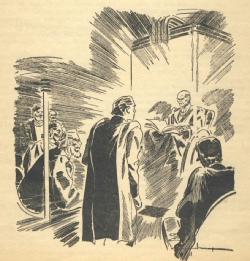The Predictability of People
A recurrent theme in science fiction is the idea that individuals can make revolutionary differences, and that new discoveries can change the future path of discovery. However a subset of science fiction has actually argued the reverse - that while individuals are unpredictable, the broad social and cultural trends of human populations are entirely predictable and can even be manipulated. Here we take a look at some of these ideas and what they have to tell us.
The Father of Psychohistory
 First published in short story form in 1942, Isaac Asimov’s Foundation series introduced science fiction readers to the character Hari Seldon and the science he founded: psychohistory. Continually expanded by Asimov over the next half-century, the premise of this future history is built on one simple presumption: the fall of the Galactic Empire of Seldon’s time is inevitable and unpreventable, but the millennium of barbarism that will follow may be averted if the science of psychohistory is correctly deployed.
First published in short story form in 1942, Isaac Asimov’s Foundation series introduced science fiction readers to the character Hari Seldon and the science he founded: psychohistory. Continually expanded by Asimov over the next half-century, the premise of this future history is built on one simple presumption: the fall of the Galactic Empire of Seldon’s time is inevitable and unpreventable, but the millennium of barbarism that will follow may be averted if the science of psychohistory is correctly deployed.
In defining psychohistory, the novel of Foundation quotes snippets from the (fictional) Encyclopedia Galactica:
“Gaal Dornick, using non-mathematical concepts, has defined psychohistory to be that branch of mathematics which deals with the reactions of human conglomerates to fixed social and economic stimuli…. Implicit in all these definitions is the assumption that the human conglomerate being dealt with is sufficiently large for valid statistical treatment. The necessary size of such a conglomerate may be determined by Seldon’s First Theorem which… A further necessary assumption is that the human conglomerate be itself unaware of psychohistoric analysis in order that its reactions be truly random…”
Simply put - populations can be predicted, and their collective behaviour modified to follow required paths, so long as the population remains unaware of the manipulation. Seldon’s Foundation is put in place to create a population that can be manipulated this way while also acting as caretakers of civilisation's knowledge. In the end, however, Seldon’s great plan is disrupted by the emergence of a human mutation that lies outside the scope of psychohistorical theory - demonstrating the ever-present risks of unpredictable individual elements derailing any grand statistical scheme. Interestingly Asimov’s novels have the kernel of their own counterargument at their core. While Asimov did indeed predict the impact that can be made by outstanding individuals - such as the mutant Mule - in changing predicted trends, it passes without comment that Hari Seldon was himself such an outstanding individual, whose contribution to psychohistory could change the path of civilisations and who couldn’t have been predicted by a psychohistorical analysis.
Asimov's writing was famously influenced both by his reading of Gibbon's The History of the Decline and Fall of the Roman Empire (1776), and by discussions with Astounding Science Fiction magazine editor John W Campbell (who had an interest in symbolic logic). In the decades since Foundation was published numerous articles and essays have explored its influence and also considered the accuracy of Asimov’s predictions - as well as the general concept that people can be predicted at all [1]. However Asimov's work and its associated literature hasn’t been alone in exploring this area.
Psychotechnics

Since the introduction of psychohistory a number of other science fiction authors have explored the idea of shadowy cadres who can manipulate human history and society on long timescales, using a grounding in human psychology as their principle tool. This tends to be a literary science fiction trope - the timescales and focus on populations rather than individuals making it a challenging topic to tackle on either the large or small screen.
Poul Anderson explored this issue in his novels and short stories in the Psychotechnic League series (short stories and novels, 1949 onwards). These are set in a history in which a devastating world war in the late 1950s presages a reconstructed society in which the practitioners of a mathematical sociology use the United Nations as a form of world government in order to avoid another and more devastating war. A running theme is the idea that human technical development has been faster than its moral and social development, and so human culture needs to be carefully guided, in order to prevent it destroying itself before it can mature. This effort is itself described as a war, and in terms that show little faith in humanity: “The enemy was old and strong and crafty, it took a million forms and it could never be slain. For it was man himself - the madness and sorrow of the human soul, the revolt of a primitive against the unnatural state called civilisation and freedom” (“The Un-man”, Anderson, Astounding SF, Jan 1953).
 The term psychotechnology and its associated words had been in use since the early 1900s to describe “The branch of psychology that deals with the practical application of knowledge about the human mind or brain” (OED.com). Although seldom used now, it distinguished those who sought to manipulate thought from the psychologists who sought only to understand it. A recurring theme in Anderson’s series is the danger that might follow from such techniques becoming public knowledge, and the sinister possibilities they present:
The term psychotechnology and its associated words had been in use since the early 1900s to describe “The branch of psychology that deals with the practical application of knowledge about the human mind or brain” (OED.com). Although seldom used now, it distinguished those who sought to manipulate thought from the psychologists who sought only to understand it. A recurring theme in Anderson’s series is the danger that might follow from such techniques becoming public knowledge, and the sinister possibilities they present:
“But just what kind of person is needed?” Elena asked coldly. “Who decides it? You do. You’re just the same as all other reformers, including [nationalist autocrat] Meade - hell-bent to change the whole human race over to your particular ideal, whether they like it or not.”
“Oh, they’ll like it,” he smiled. “That’s part of the process.”
“It’s a worse tyranny than whips and barbed wire!” she snapped.
(“The Sensitive Man”, Anderson, Fantastic Universe, November 1953)
Another of Poul Anderson’s (non-psychotechnic league) stand-alone novels, Planet of No Return (a.k.a. Question and Answer, serialised 1954, novel 1956), describes a mission to a potentially habitable world, perhaps the last hope for crewed interstellar spaceflight for a human race who has become disenchanted with the expense and difficulty of exploration. This novel also discusses the existence of psychocrats - a clique of behind-the-scenes political advisors, who prove to have their own ambitions for how to engineer the next millennium of human history, ones that may or may not align with the objectives of the humans being engineered. They take the long view, and - as with Asimovian psychohistory - they find it important not to work in the open. As one character tells us:
“It is history, and the equations which interpret and explain and predict history”... ”You can’t change society overnight. It will take a thousand years of slow, subtle, secret direction - propaganda here, education there, the hidden interplay of economics and religion and technology - to evolve the culture we want. It won’t look like anything which has gone before.”
The question of whether they’re prepared to wait a thousand years, or whether the planned culture is desirable in the first place is one that the central characters must answer for themselves.
A similar plan for manipulating the human race can be found in the military science fiction novel Dorsai! by Gordon Dickson (serialised in Astounding, May-July 1959). Here humanity has splintered amongst a number of planets and groups each of which specialise, as the titular Dorsai specialise in acting as soldiers. Amongst the central characters, ArDell Montor is an expert in Social Dynamics - a predictive system of mathematics for describing populations - and comes from a planet called Newton which specialises in the sciences. As we’re told towards the end of the novel:
“But you know what was behind Montor’s science, don’t you? It treated the human race as a whole, as a single social entity, self-repairing in the sense that as its individual components die off they are replaced by the birth of new components. Such an entity is manipulable under statistical pressures, in somewhat the same manner that a human being may be manipulated by physical and emotional pressures. Increase the temperature of a room in which a man stands, and he will take off his jacket.”
However the details of social dynamics are never really discussed. In this case, as in several of the others mentioned here, this science is ultimately shown to be futile, and, in Dorsai, the mathematical approach of Social Dynamics is pitched in opposition against another group who are instead attempting to shape the future by selective breeding.
Snowball Effects
An interesting aspect of societal manipulation is that its effects tend to grow exponentially (i.e. increasing from a small start by ever larger steps). By the time a movement or historical event is imminent, it represents the culmination of many occurrences which collectively have brought the society to that point. A small change made early in the historical sequence can trigger other small events and these collectively lead to a much more significant change years, decades or centuries down the line.
 Katherine McLean’s short story “The Snowball Effect” (Galaxy, September 1952, adapted for the radio series X-Minus-One by Ernest Kinoy) explores this idea while striking a far lighter note. The story focuses on a university administrator attempting to balance his books, who challenges the sociology department to prove its worth. Professor Caswell, from that department, offers to demonstrate how the growth of organisations can be mathematically described and manipulated, using his mathematical formalism:
Katherine McLean’s short story “The Snowball Effect” (Galaxy, September 1952, adapted for the radio series X-Minus-One by Ernest Kinoy) explores this idea while striking a far lighter note. The story focuses on a university administrator attempting to balance his books, who challenges the sociology department to prove its worth. Professor Caswell, from that department, offers to demonstrate how the growth of organisations can be mathematically described and manipulated, using his mathematical formalism:
“In working on the problem, I found that the mathematics of open system, as introduced to biology by Ludwig von Bertalanffy and George Kreezer, could be used as a base that would enable me to develop a specifically social mathematics, expressing the human factors of intermeshing authority and motives in simple formulas.”
To demonstrate this, he offers the local Watashaw Sewing Circle a new set of bye-laws designed to ensure its exponential growth and then eventual collapse when it stops recruiting. The professor’s expectation that the club’s expansion would fizzle out when it ran out of local women with an interest in sewing goes disastrously awry when the club changes its remit first into a civic charity organisation and then into a national and international body… all under the terrifying leadership of the same doyenne who once dominated the sewing circle.
The same concept that very small changes result in large impacts is central to “The K-Factor” (short story, Analog, December 1960). Here, Harry Harrison defines Societics as
“The applied study of the interaction of individuals in a culture, the interaction of the group generated by these individuals, the equations derived therefrom, and the application of these equations to control one or more factors of this same culture.”
 His practitioners in the field try above all to prevent war, but on one planet, Himmel, the crucial k factor in the equations is running consistently high. This k-factor describes how likely one event is to lead to another and is analogous to the similar factor in nuclear reactions - where the difference between 0.9999999 and 1.00000001 is the difference between a controlled reactor and a nuclear bomb. The imbalance leaves the narrator operative, Neel Sidorak, with a desperate struggle to establish where the equations have gone wrong and apply his societics theories before the society in question explodes.
His practitioners in the field try above all to prevent war, but on one planet, Himmel, the crucial k factor in the equations is running consistently high. This k-factor describes how likely one event is to lead to another and is analogous to the similar factor in nuclear reactions - where the difference between 0.9999999 and 1.00000001 is the difference between a controlled reactor and a nuclear bomb. The imbalance leaves the narrator operative, Neel Sidorak, with a desperate struggle to establish where the equations have gone wrong and apply his societics theories before the society in question explodes.
Interestingly, the characters in this story discuss the fact that Societics, while sponsored by the UN-led government, and impossible for them to ignore, is also viewed with deep distrust:
“They are in the position of the man who caught the tiger by the tail. The man enjoys watching the tiger eat all of his enemies, but as each one is consumed his worry grows greater. What will happen when the last one is gone? Will the tiger then turn and eat him?”
In other words, who can be trusted with the power to manipulate entire societies and how can a government ensure the same tools aren’t used against them? Indeed this question turns out to be a valid one when the situation on Himmel proves not to be entirely accidental.
Predictable people?
Why is the idea that populations are predictable so appealing to science fiction writers?
The idea that trends emerge from the general course of human populations was not a new one, with roots in the works of scholars like Malthus, Marx, Gibbon, Spengler, Toynbee and others. The mid twentieth century saw increasing evidence that while individuals were unpredictable, societies could be manipulated en masse. The influence of mass media was highlighted in negative terms by the propaganda and social engineering that accompanied the two world wars. As consumer society developed through the second half of the century, the power of advertising became clear, while mathematical and analytic techniques were increasingly applied to economics, psychology and mathematical sociology. In particular, modern economics appeals constantly to mathematical models which attempt to predict how markets will evolve - even though individual trades and traders cannot be predicted.
Economics is perhaps an area more susceptible than most to mathematical modelling. Nobel Prize laureate and economist Paul Krugman is amongst those to speak of being inspired by Asimov’s Foundation novels, and has written about the predictability of economics - but has also noted the limits of Asimovian-style psychohistory. While broad trends and responses to individual stimuli can be predicted in the short to medium term, this is a long way from the centuries of specific events and crises described by the Foundation’s Seldon plan. Krugman, like many others, has argued that Seldon-esque psychohistory is simply impossible as described.
Later in the twentieth century, understanding of chaos theory developed - making clear that tiny effects not only grow in snowball fashion (as Katherine McLean’s story described) but do so unpredictably and with near-random sensitive dependence on initial conditions. This means that not only changes deliberately being applied but also tiny variations in those changes (too small even to be detected at the time) can completely change eventual outcomes. This chaotic evolution makes long term prediction (of the weather or anything else) impossible, and attempted manipulations dangerous at best. In the language of “The K factor” perhaps we’re aiming to introduce a change with value 1.00000 and are content that we have done so to the best of our ability to measure it. But the true value may be 1.00000(005) where the last few digits are unmeasurable - and in any exponential growth situation such as a nuclear reaction, this slight difference from the target is enough to change a stable reaction into a runaway explosion.
Despite this, the Foundation novels in particular have an ongoing appeal. The series was recently filmed for television (Apple TV, 2021), and the new adaptation was accompanied by a slew of discussion regarding the power of psychohistory, and of science fiction as prediction more generally, in the context of modern social media and information technology. As many of these pointed out, the mathematical models now used to predict demographic growth, voting trends, economic processes and other societal processes, as well as advertising yields and strategies, are undoubtedly more advanced than those known when Asimov was writing. The power of algorithms working on big data have already been seen in the manipulation of social media feeds, and could prove still more influential in future as autonomous learning algorithms have ever bigger databases to learn from, and more influence to shape the news and information we receive.
While the other examples mentioned here are less well known, they each raise similar questions: whether populations really are predictable by equations and statistics, whether those can be manipulated, and whether they should be. Perhaps fortunately, while the answer to the first question may be a qualified yes, the answer to the second is still (despite big data algorithms) a firm no. And hence the third question does not arise.
An interesting aspect of many of these stories is the positioning of science and scientists. In quantum physics, the act of observing changes that which is observed. In the same way, Asimov, Anderson and Harrison all stressed how important it was for the population being manipulated not to know what was happening, lest that change their behaviour and affect the manipulation.
In both Anderson’s Psychotechnic League and Asimov’s Foundation series the practitioners of social manipulation describe themselves as scientists, where “scientist” is conflated with “guardian of knowledge” and in particular with the role of guardian of that knowledge against a potential decline into barbarism. This places scientists as distinct from or even in opposition to politicians. Indeed, the initial goal of the Foundation was production of an Encyclopaedia Galactica containing all human knowledge and the Encyclopaedists see themselves as aloof from all political conflicts - a character notes that “It’s none of our business. We are first of all and last of all—scientists. And our concern is the Encyclopedia.”
 Perhaps unsurprisingly it came as a real shock to the Encyclopaedists when Hari Seldon’s recorded image admitted that: “It is a fraud in the sense that neither I nor my colleagues care at all whether a single volume of the Encyclopedia is ever published.” Instead, the true aim of the Foundation is the preservation specifically of scientific or technical expertise (such as the manipulation of nuclear power) and the reseeding of civilisation with that expertise. While this focus on science aligns with one of the underlying premises of science fiction, it diminishes the importance of cultural, historical or other forms of traditional and social knowledge - any of which may also ultimately prove important to a future society. It also explicitly ignores the fact that scientists are themselves are part of society, are shaped by it and cannot stand entirely apart from it. For Poul Anderson’s Psychotechnic League the secrecy and stresses resulting from this and from the need to keep their work secret were seen as a social obligation on the Psychotechnic Institute:
Perhaps unsurprisingly it came as a real shock to the Encyclopaedists when Hari Seldon’s recorded image admitted that: “It is a fraud in the sense that neither I nor my colleagues care at all whether a single volume of the Encyclopedia is ever published.” Instead, the true aim of the Foundation is the preservation specifically of scientific or technical expertise (such as the manipulation of nuclear power) and the reseeding of civilisation with that expertise. While this focus on science aligns with one of the underlying premises of science fiction, it diminishes the importance of cultural, historical or other forms of traditional and social knowledge - any of which may also ultimately prove important to a future society. It also explicitly ignores the fact that scientists are themselves are part of society, are shaped by it and cannot stand entirely apart from it. For Poul Anderson’s Psychotechnic League the secrecy and stresses resulting from this and from the need to keep their work secret were seen as a social obligation on the Psychotechnic Institute:
“It’s another discovery of the Institute for which we don’t think the world is ready. It’d be too big a temptation for too many people to create followers like me.” He looked away, into the windy dark. The scientist is also a member of the society, and has a responsibility toward it. This - restraint - of ours is one way in which we meet that obligation.” (“The Sensitive Man”, Anderson, Fantastic Universe, Nov 1953)
Of course, as had been pointed out before, such obligations are predicated on the questionable assumption that the psychotechnics, psychohistorians, Societics practitioners and others are correct in their goals and can be trusted to use their knowledge responsibly. Science fiction, as we’ve seen, provides both cautionary tales and positive possibilities to take away from mathematical sociology, psychohistory and their ilk. As the data available on both individuals and cultures continues to grow exponentially, it is possible that our current predictive algorithms will become more powerful. While they’ll likely never reach the precision of psychohistory, science fiction warns us to be wary of the consequences of such predictions.
"The Predictability of People", Elizabeth Stanway, Cosmic Stories blog, March 2024.
Note:
[1] There has been a lot of academic work on this. An interesting set of recent essays on psychohistory, free will, symbolic logic and associated issues can be found in the collection Asimov's Foundation and Philosophy, edited by Joshua Heter and Josef Thomas Simpson (2023).
The views expressed in this blog entry are those of the author and do not necessarily reflect those of the University of Warwick. All images sourced online and used here for purposes of academic commentary and criticism.
